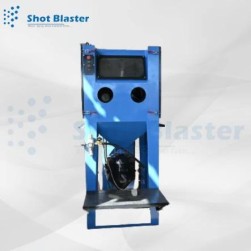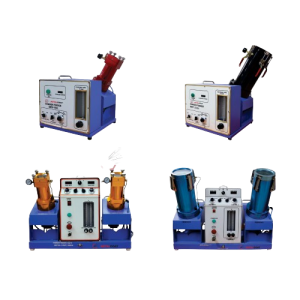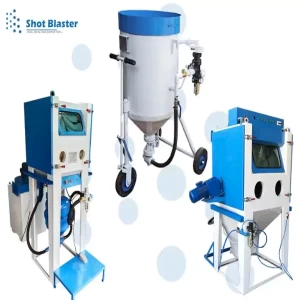Q. What is sand blasting?
Search
All Categories & Products

Abrasive Blasting Machine
Abrasive blasting is a loose abrasive machining process. The abrasives stream (also called media) is propelled with compressed air or the centrifugal force (induced by a spinning wheel) against the workpiece surface at high speed.

| Product | Abrasive Blasting Machine |
| Grade | Automatic, Semi-Automatic, Manual |
| Material | Mild Steel |
| Power | 12.5hp |
| Voltage | 440V |
| Frequency | 50Hz |
An abrasive blasting machine uses pneumatic, hydraulic, & centrifugal power to impart abrasive materials to surfaces. In complement to a force of rebounding material, abrasive blasting challenges include the toxicity of the abrasive substance & the abraded surface. We also deliver all types of abrasive blasting machines like sand blasting, shot blasting machine, and grit blasting machines, etc.
Blast Cleaning Enclosures
Two basic types of chambers are employed for abrasive blasting:
Abrasive Blasting Cabinet
A section wherever the operative stands outside, operating necessary controls or abrasive sand blasting nozzle from the cover of the chamber.
Specific operating requirements
- Ventilation is essential to ensure certain air flows continuously via almost all of the enclosure's apertures when blasting. Following blasting, the exhaust must quickly clean the dusty air within the abrasive sand blasting cabinet.
- Inlets & access holes should be baffled to prevent abrasive & dust bits from escaping into neighboring job areas. There are no obvious blasts of dust. Slit, abrasion-resistant baffles are required at any minor access points wherever dust may escape. These should be examined on a regular basis & changed as needed.
- Before extending the cabinet, blast must be rotated off & exhaust system activated for long enough to clear the dusty air inside.
- Safety glass with screening is required for adherence windows that employ hard-cutting abrasives.
- Doors should be flanged & fit tightly when closed.
- Dust leaks must be addressed soon.
- Static pressure drop at exhaust ducts should be monitored after installation & on a regular basis afterward to ensure proper operation.
- Exhaust ducts must be cleaned if there is proof of a partisan blockage.
- An abrasive partition should be encountered in systems wherever abrasive media is recirculated.
- The cabinet's air exhaust will be vented via dust collector equipment.
- Dust collectors must be fitted so that collected dust may be unloaded & extracted without polluting adjoining employment areas.
Blast Cleaning Room
A thorough compartment in whichever abrasive blasting is completed with the operator operating inside the room.
Specific operating requirements
- Ventilation ensures that air flows continuously into the space through all entrances & different openings.
- Doors to abrasive sand blasting rooms must be operable from both inside & external. If there is a tiny operative entrance door, the main job entrance door can only be closed & extended from the outside.
- Static pressure reduction at exhaust ducts should be monitored after installation & on a regular basis afterward to ensure proper operation.
- Exhaust ducts must be cleaned if there is proof of a partisan blockage.
- An abrasive separator should be engaged in systems wherever the abrasive is recirculated.
- The room's air exhaust will be released via dust collection equipment.
- Dust collectors must be fitted so that collected dust may be unclogged & extracted without polluting contiguous job areas.
Abrasive Blasting Equipment
An air abrasive blasting equipment system is comprised of several primary elements, including the subsequent.
- Air Compressor
- Blast Pot (Pressure Blast Tank)
- Abrasive (Blast Media)
- Blast Nozzle
- Moisture Trap
- Deadman Handle
- Blast helmet
- Interconnect Hoses
Let’s take a look at each to see how they function together to provide an efficient abrasive blast system.
Air Compressor
The air compressor generates heightened pressure air for sand blasting machine process. This machine handles in ambient air at 14.7 psi & capsulizes it to a pressure many times more elevated, often around 120 psi. An air intercooler helps to disperse part of the heat created during compression. while the air exits the compressor, it travels through moisture & oil separators to ensure certain it is dry & free of oil.
Air compressors are generally identified by output capacity, like 250 CFM, 325 CFM, or 750 CFM. CFM means cubic feet per minute, whichever is how importance of pressurized air is measured. Power to run a compressor is usually supplied by an interior explosion engine (gasoline & diesel) & by an electric motor. The preference of a power unit is typically dictated by area wherever blasting is to be executed & by availability of utilities.
Blast Pot
The blast pot is a coded pressure vessel also known as a pressure blast tank. As it is a pressure vessel, it must include a stamp indicating specific it has been pressure tested. The pressure blast tank is again distinguished by its size. Depending on how much abrasive it could store, it may be demanded to like a 6-ton pressure blast tank & a 6-sack pot (made of silica quartz sand). During operation, the blast pot is pressured & injected into air streamlet.
Abrasive Media (Blast Media)
While not commonly associated along abrasive blasting, the exterior does not change significantly without abrasive media. Abrasives are categorized as either disposable (one-time benefit) & recyclable. The style, size, shape, & hardness of abrasive media all influence productivity, as does depth &form of the texture profile & commentator pattern. The cleanliness of abrasive media is equally crucial to cleanliness of the compressed air utilized to push it. Before utilizing fresh & recycled abrasive, it is subjected to a vial test. abrasive media is tested for oil & conductivity in conformity additionally ASTM D7393 & D4940, respectively. As stated by to SSPC requirements, abrasives must not include any visible oil & maintain a conductivity greater than 1,000 S.
Sand Blast Nozzle
Abrasive blasting nozzle is a tiny though vital ingredient of blasting equipment. It is final ingredient to have an impact on explosion media. Nozzles can be distinguished by their shell material, lining arrangement, orifice size, & length. Orifice size numeral represents the size in 1/16-inch units (#7 = 7/16-inch). The nozzle size concerns amount of air & abrasive utilized, as well as the abundance of job performed. The bigger nozzle, the more supplies consumed. Nozzles are preferred for appointment to be done.
Moisture Trap
The moisture trap is a mechanism certain permits compressed air to release water. while air is compressed, warmth is constructed. Water in suspension (humidity) condenses as hot air travels via a warmness exchanger to reduce the air temperature. Typically, an air compressor contains a moisture trap. This initial trap collects majority of water. However, when pressurized air cools, extra moisture concentrates in bull hoses. Moisture separator traps leftover moisture right before it reaches pressure blast tank. This trapping is accomplished additionally either a centrifuge-style separator or a changeable filter component separator. When blasting, an air bleed valve at bottom of the moisture trap should be left open to authorize moisture to be ejected.
Deadman Valve
The deadman valve, either pneumatic & electrical, permits blaster to maintain remote control valve over the pressurization of the blast hose. Along the pneumatic process, this is accomplished when pressure via the deadman valve completes the air control valve and opens an pullback valve. This discourages air from penetrating the pressure blast tank & at the same time, it depressurizes pressure blast tank. Electrically powered systems perform pinch valves to stop blast hose combustion. When the bull pipe is affixed & pressured in electrically regulated systems, the pressure blast tank is automatically pressurized.
The deadman switch's principal objective is to ensure safety. It allows you to halt avoidance of abrasive from the nozzle if a safety danger occurs. The fact certain it permits the blaster to start & stop job at his leisure serves as a supplementary benefit.
Sand Blast Helmet
The blast helmet is a portion of safety gear that produces a degree of comfort to the blaster as well. This helmet is typically a reinforced plastic shell additionally a replaceable skirt certain protects the torso of the blaster. It has a double-faced shield of clear plastic for eye protection & an air space line to deliver favorable pressure beneath the sand blasting helmet. Approving air pressure underneath helmet prevents entryway of toxic blasting dust & abrasive. Air coolers are even unrestricted. If air is arriving from a diesel compressor, an air purifier & carbon monoxide monitor are needed.
Abrasive Blasting Hoses
Hose sizes differ according to the task to be done, unrestricted air capacity, distance to function area, & supplemental factors. The bull hose comes rather in the sequel. This is a short hose, > 50 feet long, additionally an interior diameter (ID) of 2.5 inches & less, certain transports air from the compressor to the pressure blast tank. The following sand blasting hose is an air-line additionally an inexact ID of 0.75 inches & less certain furnishes air rather to a moisture trap & then to the blast helmet. The department betwixt the moisture trap & the helmet is shorter, down to 0.25-inch ID.
Control hoses could be down to 0.20-inch ID & are typically dual-line hoses. They function from the control valve on the pressure blast tank to the deadman switch & back to conclude rotation when the blaster is prepared to commence creation. Incorporated here is the electrical wiring required if the deadman is electrically worked. It typically functions from a 12-volt DC basis like the compressor power unit’s DC system.
The final hose in the circuit is the blast hose. It is a thick-walled, wire-strengthened hose developed and built to handle the elevated pressure air (until 120 psi) & abrasive mixture certain travels from the pressure blast tank to the blast nozzle. Sand blast pipe is composed of three coatings: an internal wearing liner, a conductive thermal spray coating, & an outside wrapping. Abrasive going through a blast hose generates static electricity. The conductive coating is needed so the entire system could be dropped. While a broad rule, hose should be 3 times the ID of the nozzle orifice; ideally, 1.25-1.5 inches for optimum production.
Abrasive Blasting Machine Manufacturer in India
We are the best abrasive blasting machine manufacturer and supplier of abrasive blasting equipment in India and worldwide. We also provide all types of abrasive shot blasting machines, sand blasting machines, shot blasting machines, dustless blasting machines, thermal spray guns, tungsten carbide coating, sand blasting spare parts, abrasive media, and mineral powder with the best quality & grade.
Ans.
Sand blasting is the activity of coercively impelling a surge of abrasive material against a surface constrained to smooth an unpleasant surface, roughen a smooth surface and shape a surface, or eliminate the surface pollutants. Sand used to be the most usually utilized material, however since the lung infection silicosis is brought about by broadened inward breath of the residue made by sand, different materials are currently utilized in their place.
Q. What is difference between shot blasting and sand blasting?
Ans.
Sand blasting and shot blasting both are the cycle which is being used in mechanical surface cleaning. Many industries that utilization metal applies these techniques in everyday rehearses for eliminating consumption, paint, and different movies and setting up the surface for covering. In the two techniques, cast ironwork is additionally impacted to eliminate old paint layers. In any case, the contrasts between the two cycles are just for rule and application types.
Q. Why Sand blasting is done?
Ans.
The main purpose behind sand blasting is to eliminate paint or rust and other surface-toxins from hardware, vehicles, houses, and practically some other surface. In the interim, it is a surface treatment measure broadly utilized in a wide range of enterprises for different purposes.
Q. What is the use of Sand blasting?
Ans.
To remove paint or rust from the surface Sand blasting is highly recommend. This cycle is coercively impelling a surge of grating material against a surface constrained to smooth or unpleasant the surface. Sand blasting can prompt the paint to look lopsided when it fixes and bubbles once the task gets wrapped up.
Q. What is a Sandblaster job?
Ans.
The sandblaster works to clean and scrape a surface, regularly metal, of any rust, paint, or other undesirable surface materials. In this innovation, the hose associates with the air tank, and the hopper is loaded up with a grating to guarantee the best outcomes with no obstacles.

